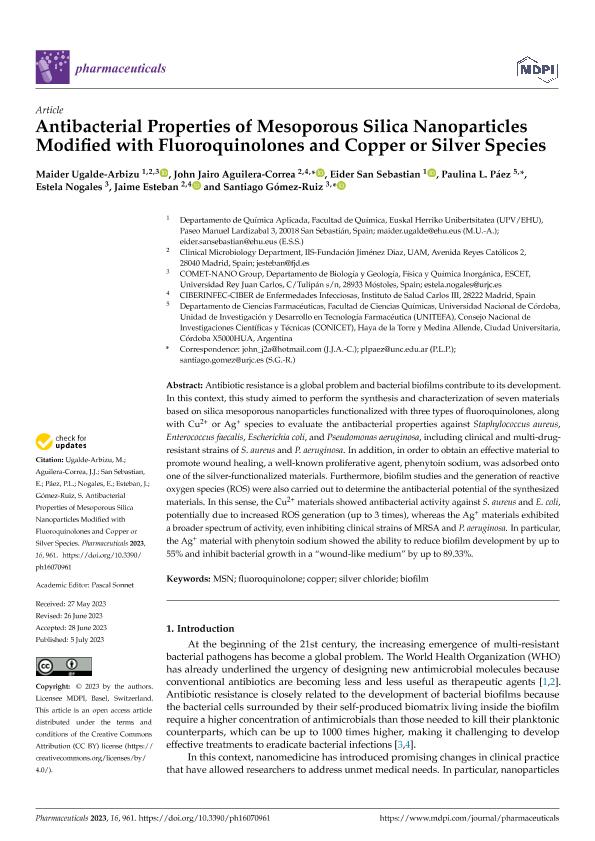Artículo
Antibacterial Properties of Mesoporous Silica Nanoparticles Modified with Fluoroquinolones and Copper or Silver Species
Ugalde Arbizu, Maider; Aguilera Correa, John Jairo; San Sebastian, Eider; Páez, Paulina Laura ; Nogales, Estela; Esteban, Jaime; Gómez Ruiz, Santiago
; Nogales, Estela; Esteban, Jaime; Gómez Ruiz, Santiago
 ; Nogales, Estela; Esteban, Jaime; Gómez Ruiz, Santiago
; Nogales, Estela; Esteban, Jaime; Gómez Ruiz, Santiago
Fecha de publicación:
07/2023
Editorial:
Multidisciplinary Digital Publishing Institute
Revista:
Pharmaceuticals
e-ISSN:
1424-8247
Idioma:
Inglés
Tipo de recurso:
Artículo publicado
Clasificación temática:
Resumen
Antibiotic resistance is a global problem and bacterial biofilms contribute to its development. In this context, this study aimed to perform the synthesis and characterization of seven materials based on silica mesoporous nanoparticles functionalized with three types of fluoroquinolones, along with Cu2+ or Ag+ species to evaluate the antibacterial properties against Staphylococcus aureus, Enterococcus faecalis, Escherichia coli, and Pseudomonas aeruginosa, including clinical and multi-drug-resistant strains of S. aureus and P. aeruginosa. In addition, in order to obtain an effective material to promote wound healing, a well-known proliferative agent, phenytoin sodium, was adsorbed onto one of the silver-functionalized materials. Furthermore, biofilm studies and the generation of reactive oxygen species (ROS) were also carried out to determine the antibacterial potential of the synthesized materials. In this sense, the Cu2+ materials showed antibacterial activity against S. aureus and E. coli, potentially due to increased ROS generation (up to 3 times), whereas the Ag+ materials exhibited a broader spectrum of activity, even inhibiting clinical strains of MRSA and P. aeruginosa. In particular, the Ag+ material with phenytoin sodium showed the ability to reduce biofilm development by up to 55% and inhibit bacterial growth in a “wound-like medium” by up to 89.33%.
Palabras clave:
BIOFILM
,
COPPER
,
FLUOROQUINOLONE
,
MSN
,
SILVER CHLORIDE
Archivos asociados
Licencia
Identificadores
Colecciones
Articulos(UNITEFA)
Articulos de UNIDAD DE INVESTIGACION Y DESARROLLO EN TECNOLOGIA FARMACEUTICA
Articulos de UNIDAD DE INVESTIGACION Y DESARROLLO EN TECNOLOGIA FARMACEUTICA
Citación
Ugalde Arbizu, Maider; Aguilera Correa, John Jairo; San Sebastian, Eider; Páez, Paulina Laura; Nogales, Estela; et al.; Antibacterial Properties of Mesoporous Silica Nanoparticles Modified with Fluoroquinolones and Copper or Silver Species; Multidisciplinary Digital Publishing Institute; Pharmaceuticals; 16; 7; 7-2023; 1-21
Compartir
Altmétricas



